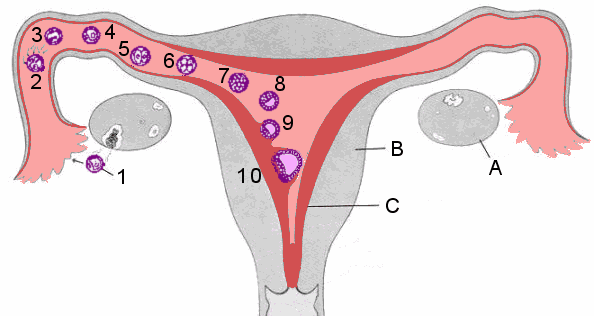|
4.1.4 FERTILIZATION
When an egg is released from one of the ovaries, it almost immediately enters the open end of the adjacent Fallopian tube. As it travels down this tube toward the uterus, it matures to become ready for the union with a sperm cell. Within a few hours, the egg reaches maturity while it is still in the upper third of the Fallopian tube. This is the time when the sperm should arrive if a fertilization is to occur. The entire period in which egg and sperm can unite is less than twenty-four hours. If no such union takes place, the egg dies and disintegrates. However, moving into the Fallopian tube, the egg may very well encounter live sperm cells which have arrived and stayed there following coitus several days before. (Sperm cells have been found alive inside Fallopian tubes up to five days after coitus.)
When sperm cells are ejaculated, they are swimming in a thick, greyish-white fluid called semen. Following coitus, the semen is deposited close to the entrance of the uterus. The total volume of semen thus discharged at one time is less than a teaspoonful, but it contains between 200 and 500 million sperm cells, which now try to move into the uterus and onward up into the Fallopian tubes. However, unless an egg has been released by one of the ovaries around that time, the opening of the uterus will be plugged by an impenetrable, thick mucus. Only during ovulation does this mucus become thin enough to be penetrated by sperm cells. Even then, only about 1 percent of them succeed. The others die within a few hours in the slightly acidic, and therefore hostile, environment of the vagina. Those sperm cells that enter the uterus find themselves in a slightly alkaline, and therefore friendly, environment. Furthermore, muscular movements of the uterus and Fallopian tubes help them along on their way. Nevertheless, only a few hundred or a few thousand ever reach that upper part of the tubes where a union of egg and sperm can occur. (Naturally, the sperm cells enter both tubes whether an egg is present or not.)
FROM OVULATION TO IMPLANTATION
 |
1 Ovulation 2-4 Fertilization 5-8 Segmentation 9-10 Implantation
A: Ovary B: Uterus C: Endometrium
(Size and dimensions of various elements in this drawing have been exaggerated for the purpose of illustration.)
Usually, several sperm cells reach the egg at the same time. However, only one of them penetrates it, because immediately upon first penetration a chemical change in the outer layer of the egg prevents any additional sperm cells from breaking through. As soon as it enters the egg, the sperm cell loses its tail. The compact sperm swells and forms a small nucleus which then unites with a similar small nucleus developed by the egg. The entire process is called fertilization. It is complete when the twenty-three chromosomes derived from the nucleus of the sperm have joined with the twenty-three chromosomes derived from the nucleus of the egg. Thus, a new cell containing forty-six chromosomes is formed. It combines the inheritable characteristics of both man and woman. This new cell, which is the direct result of fertilization, is called a zygote.
|

